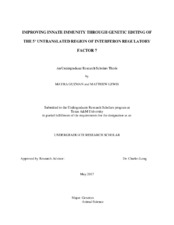| dc.description.abstract | Disease decreases production efficiency and kills millions of animals across all types of livestock operations every year. This is severely detrimental to both animal producers and consumers from an economic and overall food supply standpoint. Unfortunately, many current options for disease control prove to be impractical in various situations. Vaccines are costly to administer, can require several boosters over extensive periods of time to become effective, can become ineffective due to rapid viral mutations, and some diseases still do not have effective treatments or vaccines. Therefore, alternative methods of disease control must be implemented in order to better protect livestock and the agricultural industry. Type I interferons (IFN) are the first line of defense against viral pathogen invasions in animals and humans. Type I IFNs are activated by the master regulator, interferon regulatory factor 7 (IRF-7). In turn, IRF-7 can be inhibited by 2'-5'-oligoadenylate synthase-like protein 1 (OASL-1), eukaryotic translation initiation factor 4E-binding protein 1 (4E-BP1), and eukaryotic translation initiation factor 4E-binding protein 2 (4E-BP2), (Honda, Yanai et al. 2005). OASL-1, 4E-BP, and 4E-BP2 negatively regulate IRF-7 translation and therefore, the transcription of type I IFN stimulation (Lee, Kim et al. 2013). Translational regulation of IRF-7 by OASL-1, 4E-BP1, and 4E-BP2 occurs at the complex secondary structure of the 5’ untranslated region (UTR) upstream of the translational start site. The IRF-7 5’ UTR forms several stem loops, allowing for the binding of these inhibitory proteins, therefore, reducing the number of IRF-7 5’ UTR stem loop structures may alter the binding of negative regulators and decrease IRF-7 inhibition. Genomic editing using the clustered regularly interspaced short palindromic repeats (CRISPR) CRISPR/Cas9 system will be used to alter the IRF-7 5’ UTR structure via the stem loop sequence. We hypothesize that these DNA sequence modifications will inhibit the binding of translational factors and lead to increased IRF-7 expression; ultimately causing an increased interferon response, resulting in improved resistance to viruses. This technology may also potentially increase resistance against other pathogens, creating genetically engineered animals with improved immune systems. | en |


